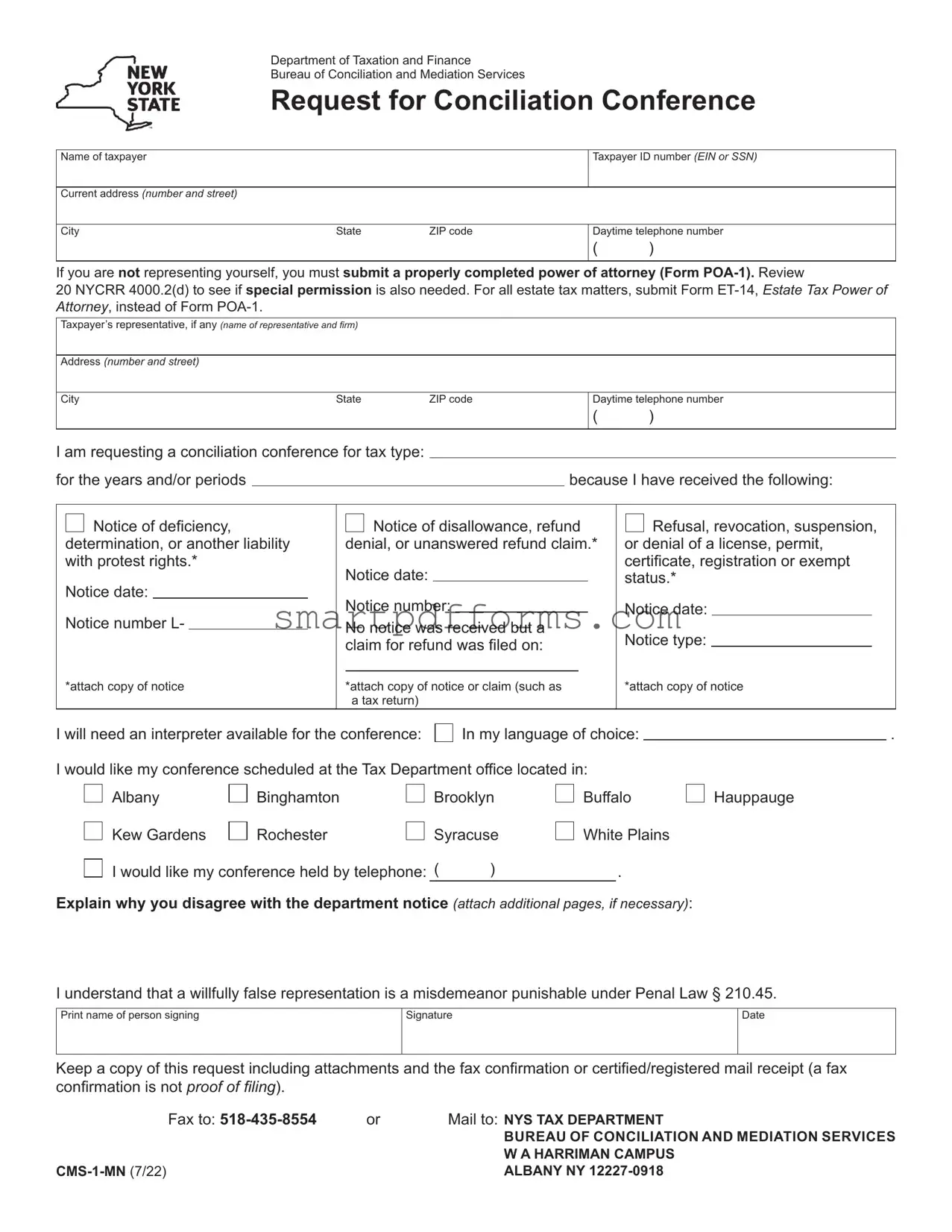Conciliation conference
A conciliation conference is an efficient and inexpensive way to try to resolve a protest. The conference is conducted informally by a conciliation conferee who will review all of the evidence presented to determine a fair result. After the conference, the conferee will send you a proposed resolution in the form of
a Consent. If you indicate your acceptance by signing and returning the Consent within 15 days, the disagreement will be concluded. Otherwise, the conferee will issue a Conciliation
Order. This order is binding on the department and will be binding on you unless you file a petition for a hearing with the
Division of Tax Appeals.
To request a conference, complete page 1 of this form and fax to 518-435-8554 or mail to the address on page 1.
Note: Failure of technology or electronic communication or
unavailability of the facsimile will not release the requestor from timely filing as required by the Tax Law.
Note: The address you provide on Form CMS-1-MN will not change any other address the department has on file for
you. If you wish to change an address you use for other Tax Department matters visit www.tax.ny.gov for directions.
Privacy notification
The right of the Commissioner of Taxation and Finance and the Department of Taxation and Finance to collect and maintain personal information, including mandatory disclosure of Social Security numbers in the manner required by tax regulations, instructions, and forms, is found in the New York State Tax Law, including subdivision 3-a of section 170 thereof; and
42 USC 405(c)(2)(C)(i).
The Tax Department uses this information primarily to administer proceedings in the Bureau of Conciliation and Mediation Services, to identify the taxpayer, and for any other purpose authorized by law.
Failure to provide the required information may subject you to civil or criminal penalties, or both, under the Tax Law.
This information is maintained by the Director of the Bureau of Conciliation and Mediation Services, NYS Tax Department,
W A Harriman Campus, Albany NY 12227-0918; telephone
518-530-4628.
Small claims option
When petitioning for a hearing, you may elect to have your hearing held in the Small Claims Unit if the amount in dispute is within the dollar limits set by the Rules of Practice and Procedure, a copy of which will be sent to you with the petition
forms. The hearing is conducted as informally as possible by an impartial presiding officer. The presiding officer’s determination
is conclusive and is not subject to review by any other unit in the Division of Tax Appeals, the Tribunal, or by any court in the state.
You may request petition forms and the Rules of Practice and Procedure of the Tax Appeals Tribunal by calling 518-266-3000, faxing your request to 518-272-5178, or writing to:
DIVISION OF TAX APPEALS
AGENCY BUILDING 1
EMPIRE STATE PLAZA
ALBANY NY 12223
Forms and publications are also available on the division’s website at www.dta.ny.gov.
A request for petition forms and the rules is not considered the filing of a petition for hearing for purposes of the time limits, and does not extend the time limits for filing a petition.
Estate tax
Estate tax filers are not eligible for hearings before the Division
of Tax Appeals.
For estate tax, if you elect not to file a Request for Conciliation Conference, you must file a Notice of Petition and a Verified
Petition with the Surrogate’s Court of the county with jurisdiction over the estate if you wish to pursue a court action. To obtain an estate tax petition form, contact the clerk of the Surrogate’s Court having jurisdiction over the estate.
A copy of the Notice of Petition and Verified Petition must be filed simultaneously with the Commissioner of
Taxation and Finance. Mail it to: Commissioner of Taxation and Finance, Office of Counsel, W A Harriman Campus, Albany NY 12227-0911.

